#d&d movie
Text

#the struggle is real#D&D#Dungeons & Dragons#Chris Pine#dnd#Dungeons & Dragons 2#Dungeons & Dragons Honor Among Thieves#D&D movie#movie#Dungeons and Dragons
3K notes
·
View notes
Text
The portal caravan scene was the most unapologetically D&D part of the movie imo
-the creative use of a magic item, not for it’s obvious and intended use
- each member of the party getting to do different parts from buying a painting to using wild shape
- the extreme convoluted nature of all the steps
- being extremely clever but still getting fucked up by bad execution(bad rolls)
-obvious holes in the plan like the guards clearly being able to see all of them working out just cause the other people are way to oblivious (when you get saved only cause an npc rolls a 5)
#dnd#D&D#d&d movie#dungeons and dragons honor among thieves#dungeons and dragons movie#honor among thieves#dnd movie spoilers#honor among thieves spoilers
10K notes
·
View notes
Text
Honestly surprised I haven't seen any head cannons that Dungeons & Dragons: Honor Among Thieves is the ST:AOS bridge crew playing D&D
3K notes
·
View notes
Text
my favorite thing about the dungeons and dragons movie was how autistic-coded the entire party was, save for edgin (who was adhd-coded)
#dungeons and dragons movie#dnd movie#d&d movie#edgin the bard#edgin darvis#xenk the paladin#xenk yendar#holga kilgore#simon aumar#doric the druid#doric#honor among thieves#dungeons and dragons honor among thieves#dndhat#winsome’s wailings
5K notes
·
View notes
Text
Dungeons and Dragons, Honor Among Thieves, spoilers without context:


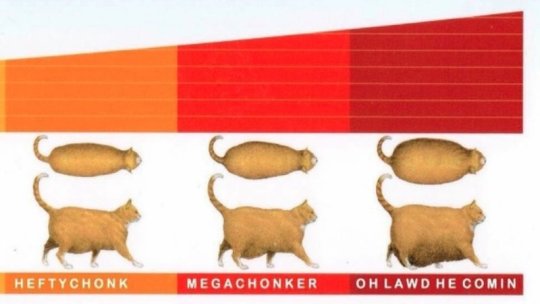
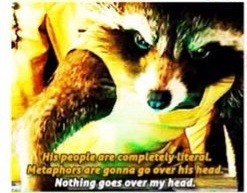

3K notes
·
View notes
Photo
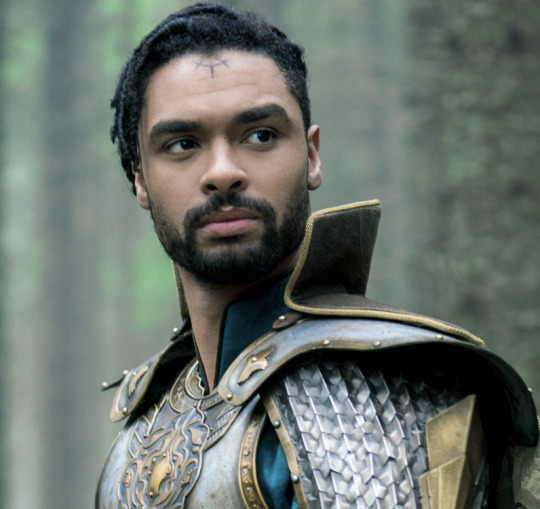
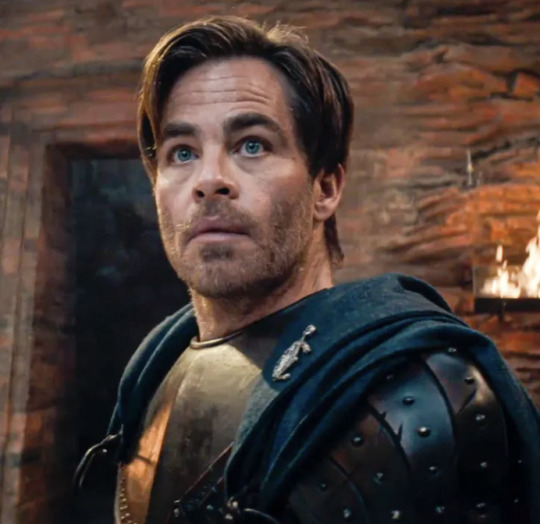
LET’S HEAR IT FOR OUR
AUTISM
X
ADHD
COUPLE OF THE FUCKING YEAR!!!!!
#dnd movie#dnd honor among thieves#xenk yendar#edgin darvis#THESE TWO AMIRITE???#xedgin#d&d movie#d&d honor among thieves#dungeons and dragons honor among thieves#my bullshit#adhd x autism#edgin x xenk
883 notes
·
View notes
Text

dnd honor among thieves without context

#dungeons and dragons#dungeons and dragons honor among thieves#chris pine#dnd movie#d&d movie#honor among thieves#dungeons & dragons#aurora talks#this movie surprised me with how much i liked it!!!!#i enjoyed myself thoroughly --- totally was thinking it was a 10/10 the entire time#it was fun and didnt take itself too seriously but also wasnt a fan wank station#and crhis pine was in it <333333333#and i loved helga sooooooooooooooooooooooooooooooooo much#i can be her tiny man
1K notes
·
View notes
Text
personally i'm strongly team DMPC, the bridge scene was soooo "DM came up with a complex puzzle for the party which they mange to royally fuck up in negative 5 seconds" and when he just walked away??? reverting back to his natural NPC state when he's no longer possessed by the soul of god
#honor among thieves#dungeons & dragons: honor among thieves#dnd honor among thieves#dnd movie#d&d movie#d&d honor among thieves
2K notes
·
View notes
Text
Okay, Edgin is a bard and yet in the High Sun games he doesn’t get a magic suppressing cuff like the other spellcasters do. THEORY: he’s a bard in the literal sense that he performs but class wise he’s a fighter that picked a lute as his weapon of choice.
#dnd movie#honor among thieves#dungeons and dragons honor among theives#d&d movie#what are we tagging this movie as gang??#this is a joke for legal reasons#i know that he has official stat blocks with magic
2K notes
·
View notes
Text
When we finished watching honor among thieves, I turned to my friends and said that I really enjoyed it, and that it was better than the old dungeons and dragons movie.
One friend turned to me and said “they were in the movie you know? In the tournament as a cameo!”
I looked at him very confused because I did not remember this lot being a team in the games but guessed I must have missed them.

Man was fuckin talking about the cartoon.

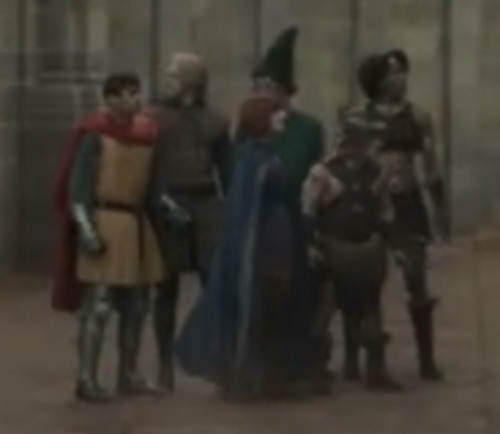
Like no bro, im talking about the 2000s movie dungeons and dragons,, I have not seen the 80s cartoon. ALSO THAT IS NOT A MOVIE,, that’s a tv show.
#dndhat#dnd movie#dnd honor among thieves#dungeons and dragons honor among thieves#d&d honor among thieves#honor among thieves#dadhat#d&d movie#dungeons and dragons 2000#dungeons and dragons movie#spoilers probably#dnd movie spoilers#dndhat spoilers#honor among thieves spoilers#dnd honor among thieves spoilers
1K notes
·
View notes
Text
Xenk is the funniest character in the D&D movie, and nobody can convince me otherwise. His scenes and his lines are so ridiculous and perfect that I can't help but laugh out loud every time.
#dnd#d&d#dungeons and dragons#honor among thieves#dungeons and dragons honor among thieves#dungeons and dragons: honor among thieves#dnd movie#d&d movie#xenk yendar#xenk the paladin
3K notes
·
View notes
Text
i love xenk. like literally im sitting there in the movie theatre for the first time with my friend and suddenly in walks this gorgeous paladin and i just immediately whisper “holy shit i love him already” aND I WAS RIGHT. this mf is both badass and adorable. holy shit he makes lawful good actually look super fun to play
#dnd#dnd honor among thieves#d&d movie#dungeons and dragons movie#xenk the paladin#xenk yendar#honor among thieves#dnd movie
1K notes
·
View notes
Text
Honor among thieves was a lot of fun and the comedy and action were on point, but my favorite part might have been the storytelling involved with Edgin’s development.
We get his backstory right away and it’s the typical death of a loved one dnd backstory but it’s told from his own self aggrandizing storytelling. And even then we have that small shot of him looking at the dragonfly. We as an audience have no idea why that is significant and you most likely forget about it because of the fast pace but it sticks in the back of your mind.
Then we have the next time we focus on the dragonfly and it cuts to his dead wife, and it appears to be the classic dead wife flashback with the bright sunbeams and nebulous white fabric. We now have a connection between the two solidified but we don’t know it means something yet.
Then in the pivotal point in the second act where the plan seems to be going to fail he has a dream and we have an explanation for the dragonfly as an image. It’s letting go, and not trying to force his life to be how we envisions it. And in this dream it reveals the shot of her from earlier wasn’t some generic image or even just them being in love but part of a specific memory Ed hasn’t wanted to think about. Plus moments later it is revealed how he was even more at fault for what happened and recontextualized a moment from the very beginning.
Finally at the end we don’t need a repeat of the flashback from earlier to know he is going to learn his lesson and let go. All we need is to see that dragonfly and we know what that means. It’s so perfect because it we as an audience feel exactly as he is. We’re remembering that specific memory based off being reminded by the dragonfly and so is Ed.
The dragonfly is a perfect visual representation of a nagging thought, something that floats up occasionally and he has been ignoring for a long time, but finally acknowledges by the end. Plus it is completely diegetic and introduced gradually and not overly telegraphed.
#d&d#dungeons and dragons#honor among thieves#dungeons and dragons movie#d&d movie#edgin the bard#edgin darvis#honor among thieves spoilers#D&D movie spoilers
2K notes
·
View notes
Text
The D&D movie is actually good! They really leaned into the humor.
Also, I can’t wait to see gif sets where dice numbers are superimposed over every action the characters take. There were some definite nat 1s in this movie.
1K notes
·
View notes
Text
Just heard on Wait, Wait, Don't Tell Me that Michelle Rodriguez had to be reminded not to use her regular Jersey accent for her character in Dungeons & Dragons: Honor Among Thieves, which means the producers had the chance to canonize human barbarians as having Jersey accents and then they DIDN'T, the COWARDS
#dnd#dnd honor among thieves#dungeons & dragons#d&d#d&d movie#dnd movie#barbarian#michelle rodriguez#wait wait don't tell me#npr
748 notes
·
View notes
Text
Why Dungeons and Dragons: Honor Among Thieves Didn't Use D&D Combat Rules (And Why They Were Right Not To)
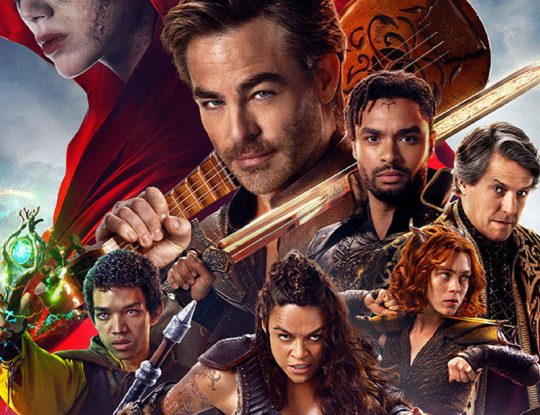
The D&D movie was really fun, and since at this point most of my friends play D&D (or at the very least other TTRPGs), almost everyone I talk to on a regular basis has also seen it and liked it. The consensus is that even though there's no "meta" that the characters are controlled by players sitting around a table, or jokes about the DM, the movie feels like D&D. The jokes feel like jokes people would make while playing. The constant pivoting from Plan A to Plan B to Plan C feels familiar to anyone who has spent an hour at a table deciding what to do, only to have a roll go sideways and screw things up. Before I get too far, I should say this post contains some mild spoilers for Dungeons & Dragons: Honor Among Thieves.
What didn't feel like D&D were the fight scenes. In one scene, a Paladin quickly dispatches a group of enemies before any of the rest of the party even acts, showcasing that even though he's kind of a square, he's an incredible fighter. In another scene, the Barbarian grabs and wears a helmet in the middle of a fight, using it creatively to get the upper hand. During a fight against a gargoyle, the Bard blinds an enemy by throwing a blanket over their head, but gets pulled along with them when a loose rope wraps around his leg. These are all pretty big moments in the movie, and Rules as Written, would never happen at a D&D table, because D&D combat doesn't work like that.
Here's what I think is interesting. The vast majority of the rules of D&D revolve around combat. It's not all of the rules, but most class abilities, spells, items, and rules have a combat focus. So why does a movie that functions partially as advertisement for the game spend so little effort to replicate the bulk of the content of the base game?
In my opinion, it's because, Rules As Written (or RAW), combat in D&D is not, generally speaking, narratively satisfying. Let's look at a few reasons why.
D&D is a game where, RAW, things either happen, or they don't. If someone misses an attack, nothing happens. If someone misses a skill check, nothing happens. DMs can work with this, but in the base game, there isn't a lot of guidance for what to do when a player fails at something they're trying to do. This may seem trivial, but compare that to something like Powered By The Apocalypse, which is much more narratively focused. In those games, a full miss means the Game Master changes things up. The enemy gets the upper hand. A new danger surfaces. An NPC is put into peril. Not only does the player fail at what they're trying to do, but something else, bad for the Player Character (PC) but good for the story, happens. On a mixed success, the PC might get what they're after, but at a cost, or with a complication they weren't expecting.
This calls to mind the example of the Bard throwing a tarp over the gargoyle in the final fight of the D&D movie. That's a classic example of a mixed success. He succeeds at temporarily blinding the creature, but in the process, he gets caught up in the gargoyle's rope and is dragged along for a ride. This is a dynamic thing to happen in combat, but wouldn't happen in actual D&D. Instead, a PC would either succeed at what they're doing, and blind the creature, or fail and not blind them. You could argue that the Bard's action was the result of a Natural 1, but that also doesn't fit RAW, because the Bard does succeed as what he's trying to do, and with a Natural 1, he would have failed and been pulled along.
D&D doesn't really reward player creativity. Something like throwing a tarp over a creature wouldn't be likely to happen in a session at all, because in the actual game, it would take a full action to do that, and depending on the Difficulty Challenge (DC) the DM sets, there's a good chance of a wasted turn. Creative actions end up a huge gamble, and when you're playing a game where it could be 20+ minutes before you get to take another turn (more like an hour if you're playing with a Wizard, amirite), you're disincentivized from "wasting" your turn to do something less than optimal. You can describe what you're doing to add to the narrative, whether you succeed or fail, but that brings me to my next point.

I haven't been able to stop thinking about this question from Rise Up Comus since I read it a month ago. In D&D, a player can describe all kinds of flavor to what they're doing, and there's no change to the mechanics of the game. You could read this as saying "Oh, well that means you have the freedom to do what you want!" but if you look at game design through the lens of "what kind of play does this game encourage or discourage" the takeaway I have is that description just...doesn't matter to D&D. In my experience, that can lead to a few different unsatisfactory outcomes.
Both players and DM treat combat as purely rolling, and describing only what is required. A DM announces, "The enemy wizard casts fireball, roll dexterity save, take 25 damage. Turn passes to the Rogue." Sometimes players who describe what they're doing are seen as showboating or taking up too much time. Worst case scenario, the DM penalizes descriptive players.
Some players like describing what they do, others don't. This has no mechanical effect on the game. Players who aren't descriptive might be frustrated that an already slow process is slowed down even more. Descriptive players may become frustrated because there's no mechanical benefit to what they're describing, and spend time fruitlessly arguing with the DM that focusing on a weak point of the enemy should give them advantage. I think most tables fall into this category. It's not a bad game by any means, but not everyone is there for the same reason when it comes to combat.
Rule of Cool Table! Everyone describes whatever they want, the dice rolls don't really matter! Combat is generally pretty easy because fuck the rules, if it's cool for the dragon to die based on how the fighter described the attack, even if it's only the first round of combat, hell yeah let's do it! For players who like being more strategic and enjoy the confines of the rule structure because it makes things challenging, these tables can be frustrating. (If you're familiar with Dungeons & Daddies, this is essentially how they play D&D).
Because there's no guideline in the rules, people come to the table with different expectations. Some people want combat to feel like a strategy game, where following the rules in the most optimal way (or combining rules elements in an unexpected way) is mechanically rewarding (usually measured by damage output). Some people want to describe themselves doing cool stuff! Some people don't care about their characters looking cool, but want the story to be compelling. If everyone isn't on the same page, this can lead to players ending combat feeling unfulfilled, and when combat is the bulk of a rules set, it feels strange to me that there's no guidance for DMs or players as to how to incentivize the kind of combat your table is interested in.
This leads to a situation where combat in D&D is the part of D&D that takes the longest, that the majority of spells and abilities are focused on, but it is, narratively, the least satisfying part of the game, unless the table alters the base rules significantly.
If you're not familiar with other TTRPGs, you might be thinking "Okay, but that's why the DM is allowed to do whatever they want and make up new rules! My DM gives inspiration when we describe something cool, that solves this problem!" My critique isn't necessarily of individual tables. DMs and players come up with all kinds of mechanics that aren't in the rules. My critique is that D&D is a role-playing game that essentially has no incentives, and many disincentives, for role-playing during combat. For example, RAW, characters don't really have time to communicate during their turns, as each round takes about 6 seconds. There's no time for banter or negotiation between PCs and enemies. You can see this disconnect by the way people talk about D&D. How many times have you heard people say "I love D&D but I don't like combat?" How could this rift be rectified? Let's take a look at some other TTRPGs.
In 7th Sea, if you take the time to describe how your character is doing something, you get a bonus to your dice pool. In Thirsty Sword Lesbians, when you get a mixed success on a Fight roll, you and your opponent are given narrative prompts to build tension (like flirt with or provoke your opponent). In Kids on Bikes, you can fail or succeed rolls by different number ranks, which determines how significant the successes or failures are. In Wanderhome, you get a token when you "take a moment to bask in the grandeur of the world, and describe it to the table." In Good Society, each player gets a "monologue token" which they can spend to prompt another player to deliver their Main Character's internal monologue. I just played a bad-action-movie-themed game called Action 12 Cinema, where players can boost a roll if they call out the song that would be playing during this scene of the movie, and get an even FURTHER boost if anyone at the table sings it.
Each of those game mechanics gives you an instant understanding into the mood of the game, and the kind of stories its built for you to tell. Even if you've never heard of any of those games, I bet, based on the title and the move, that you could hazard a guess as to what playing the game is like. Dungeons & Dragons certainly has rules that add to the lore of the game, and prompt you to create characters that act a certain way. But when it comes to combat, players and DMs are left to their own devices. Some may see that as a strength of the game, but I see it as a source for a lot of disappointing play experiences.
And it seems as though, at the very least, the writers of Dungeons & Dragons: Honor Among Thieves thought the combat rules were narratively unsatisfying enough that they eschewed using any of them.
#ttrpg design#ttrpg#indie ttrpgs#indie ttrpg#dungeons and dragons#d&d#d&d movie#please don't read this in bad faith#i just like thinking about game design
688 notes
·
View notes